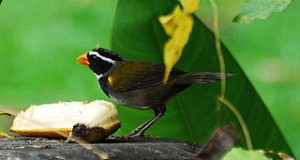 It appears that one of the world’s strangest and most endangered birds is benefiting by an equally unusual rescue plan. New Zealand’s kakapo breaks all sorts of “parrot rules”…it is nocturnal, flightless, utilizes a lek mating system (many males display before females in one location), eats leaves and grass and feeds fruit to its young. It is also the world’s heaviest parrot, and, with a population of only 90 individuals (up from 51 in 1995), the rarest. With a mean age of 90 years, it is among the longest-lived of all birds.
It appears that one of the world’s strangest and most endangered birds is benefiting by an equally unusual rescue plan. New Zealand’s kakapo breaks all sorts of “parrot rules”…it is nocturnal, flightless, utilizes a lek mating system (many males display before females in one location), eats leaves and grass and feeds fruit to its young. It is also the world’s heaviest parrot, and, with a population of only 90 individuals (up from 51 in 1995), the rarest. With a mean age of 90 years, it is among the longest-lived of all birds.
Kakapo reproduction is tied closely with the flowering of the rimu tree, the fruit of which forms the basis of the chick’s diet. The tree blooms only every 3rd year or so, and the kakapos do likewise. Already decimated by introduced stoats (weasel relatives), rats and habitat loss, the kakapo population cannot rebound under this breeding strategy.
Scientists at Glasgow University have devised a food supplement that increases female egg production in non-fruiting years. This formula is now fed to wild kakapos and has yielded promising results. Amazingly, the dedicated researchers working with this bird know every individual (by name!). They carry supplemented food to scores of feeding stations, and make certain that each bird consumes its share…surely one of the most intense conservation initiatives anywhere!
You can read more about the remarkable Kakapo Recovery Plan at:
http://www.kakaporecovery.org.nz/
Image referenced from Wikipedia Commons
 That Bird Blog – Bird Care and History for Pet Birds
That Bird Blog – Bird Care and History for Pet Birds



One comment
Pingback: Adulterous Alligators and Romantic Ravens: The Love Lives of Dinosaurs | Dinosaurs